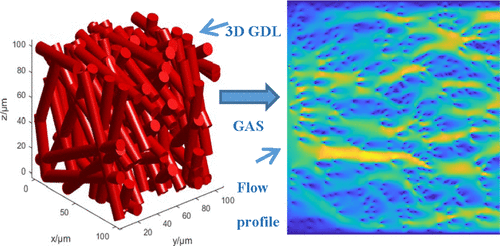当前位置:
X-MOL 学术
›
Energy Fuels
›
论文详情
Our official English website, www.x-mol.net, welcomes your feedback! (Note: you will need to create a separate account there.)
Effect of Structural Parameters on Mass Transfer Characteristics in the Gas Diffusion Layer of Proton Exchange Membrane Fuel Cells Using the Lattice Boltzmann Method
Energy & Fuels ( IF 5.3 ) Pub Date : 2021-01-26 , DOI: 10.1021/acs.energyfuels.0c03802 Jiadong Liao 1 , Guogang Yang 2 , Shian Li 2 , Qiuwan Shen 2 , Ziheng Jiang 2 , Hao Wang 2 , Lingyi Xu 2 , Mayken Espinoza-Andaluz 1 , Xinxiang Pan 2
Energy & Fuels ( IF 5.3 ) Pub Date : 2021-01-26 , DOI: 10.1021/acs.energyfuels.0c03802 Jiadong Liao 1 , Guogang Yang 2 , Shian Li 2 , Qiuwan Shen 2 , Ziheng Jiang 2 , Hao Wang 2 , Lingyi Xu 2 , Mayken Espinoza-Andaluz 1 , Xinxiang Pan 2
Affiliation

|
The gas diffusion layer (GDL) is a key component to realize effective gas transport in the electrode of proton exchange membrane fuel cells. To study the effect of different structural parameters on the mass transfer characteristics of the GDL, a developed random reconstruction algorithm is proposed to generate three-dimensional (3D) GDLs with different structures, and the lattice Boltzmann method is used to simulate the flow behavior of reactant gases in the GDL. Through the calculation of the tortuosity and the comparison with the results reported in the references, the accuracy of the model in this paper is demonstrated. The outlet velocity and average velocity of the gas, the gas phase tortuosity, and diffusivity of the GDL are calculated by changing the structural parameters of carbon fiber diameter, porosity, and thickness. It is found that increasing the diameter of the carbon fiber from 7 to 9 μm can increase the reactant gas velocity but has little effect on the improvement of GDL diffusion characteristics. Increasing the porosity from 60 to 80% can significantly increase the reactant gas velocity and improve the diffusion characteristics of the GDL. Increasing the thickness from 112 to 280 μm, the reactant gas velocity is significantly reduced, and the diffusion characteristics of the GDL are weakened, but the change is not obvious. Finally, the influence of GDL structural parameters on electrical conductivity is discussed.
中文翻译:

晶格玻尔兹曼法研究结构参数对质子交换膜燃料电池气体扩散层传质特性的影响
气体扩散层(GDL)是在质子交换膜燃料电池的电极中实现有效气体传输的关键组件。为了研究不同结构参数对GDL传质特性的影响,提出了一种改进的随机重建算法来生成具有不同结构的三维(3D)GDL,并采用格子Boltzmann方法来模拟GDL的流动行为。 GDL中的反应气体。通过计算曲折度并与参考文献中报告的结果进行比较,证明了该模型的准确性。通过改变碳纤维直径,孔隙率和厚度的结构参数,可以计算出气体的出口速度和平均速度,气相曲折度和GDL的扩散率。发现将碳纤维的直径从7μm增加到9μm可以增加反应气体速度,但是对改善GDL扩散特性影响很小。将孔隙率从60%增加到80%可以显着提高反应气体的速度并改善GDL的扩散特性。将厚度从112μm增加到280μm,反应气体速度显着降低,GDL的扩散特性减弱,但变化不明显。最后,讨论了GDL结构参数对电导率的影响。将孔隙率从60%增加到80%可以显着提高反应气体的速度并改善GDL的扩散特性。将厚度从112μm增加到280μm,反应气体速度显着降低,GDL的扩散特性减弱,但变化不明显。最后,讨论了GDL结构参数对电导率的影响。将孔隙率从60%增加到80%可以显着提高反应气体的速度并改善GDL的扩散特性。将厚度从112μm增加到280μm,反应气体速度显着降低,GDL的扩散特性减弱,但变化不明显。最后,讨论了GDL结构参数对电导率的影响。
更新日期:2021-02-04
中文翻译:

晶格玻尔兹曼法研究结构参数对质子交换膜燃料电池气体扩散层传质特性的影响
气体扩散层(GDL)是在质子交换膜燃料电池的电极中实现有效气体传输的关键组件。为了研究不同结构参数对GDL传质特性的影响,提出了一种改进的随机重建算法来生成具有不同结构的三维(3D)GDL,并采用格子Boltzmann方法来模拟GDL的流动行为。 GDL中的反应气体。通过计算曲折度并与参考文献中报告的结果进行比较,证明了该模型的准确性。通过改变碳纤维直径,孔隙率和厚度的结构参数,可以计算出气体的出口速度和平均速度,气相曲折度和GDL的扩散率。发现将碳纤维的直径从7μm增加到9μm可以增加反应气体速度,但是对改善GDL扩散特性影响很小。将孔隙率从60%增加到80%可以显着提高反应气体的速度并改善GDL的扩散特性。将厚度从112μm增加到280μm,反应气体速度显着降低,GDL的扩散特性减弱,但变化不明显。最后,讨论了GDL结构参数对电导率的影响。将孔隙率从60%增加到80%可以显着提高反应气体的速度并改善GDL的扩散特性。将厚度从112μm增加到280μm,反应气体速度显着降低,GDL的扩散特性减弱,但变化不明显。最后,讨论了GDL结构参数对电导率的影响。将孔隙率从60%增加到80%可以显着提高反应气体的速度并改善GDL的扩散特性。将厚度从112μm增加到280μm,反应气体速度显着降低,GDL的扩散特性减弱,但变化不明显。最后,讨论了GDL结构参数对电导率的影响。


























 京公网安备 11010802027423号
京公网安备 11010802027423号